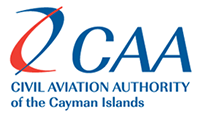Operational Requirements
Prior to placing an aircraft on the Cayman Register, the Authority must be satisfied that flight operations will be conducted in a manner consistent with internationally recognized safety standards and recommended practices (SARPs). The Overseas Territories Aviation Requirements (OTAR) were developed for this purpose.
OTAR 125 addresses the requirements for complex general aviation including corporate operations for turbine powered aircraft or large piston-engined aircraft. This regulation requires operators to have an approved Operations Manual and a Safety Management System (SMS).
Authorizations for any special operations such as Single Pilot Authority, Steep Approach and Landing Authority, MNPS, RVSM, RNP 10, RNP 5 (BRNAV) and Low Visibility Ops. are normally granted subject to meeting an acceptable means of compliance.
In order to comply with ICAO Annex 16, Environmental Standards, the Authority is required to issue a Noise Certificate. Air Navigation (Overseas Territories) (Environmental Standards) Order and OTAR Part 36 are requirements to be met. Application for a Noise Certificate is made through our VP-C online system and guidance can be obtained in the ASR Airworthiness department under the Certification Section.
NOTE: It is the policy of the Authority not to accept an aircraft on the Register unless it is at least Stage III compliant.
In order to operate in high level airspace above FL290 and to utilize aircraft navigation systems that offer fully independent or satellite based flight navigation capability, both the aircraft and the flight crew must be authorised to do so by the CAACI.
The Designated Airspace Approval Certificate identifies the Performance Based Navigation (PBN) equipment installed on the aircraft that is approved for use on the aircraft and that flight crews have been trained to operate. Typical approvals include Minimum Navigation Performance Specifications (MNPS), Reduced Vertical Separation Minima (RVSM) and Required Navigation Performance (RNP).
Follow this link to apply for the Designated Airspace Approval. The approval is usually issued for two (2) years and its scope is determined by the PBN Equipment on board the aircraft along with the level of training received by the flight crew on that equipment.
Article 37 of the Air Navigation (Overseas Territories) Order [AN(OT)O] 2013, as amended, allows owners and operators of Cayman Islands registered aircraft to operate an aircraft in accordance with the alleviations of an approved Minimum Equipment List (MEL). In order to benefit from the alleviation offered by this article, it will be necessary for owners or operators to obtain an approval from the Director General of Civil Aviation of the Cayman Islands to operate their aircraft in accordance with a MEL.
Advisory Circular 26-15; Production of the MEL provides specific directions on creating this document.
The Foreign Licence Validation is valid for one year and is contingent on the continued validity of the Flight Crew Licence submitted for validation.
All aircraft registered in the Cayman Islands are required by law to obtain a class 6 radio license in respect of the communication transceivers installed in the aircraft. The license may be obtained from the Information & Communication Technology Authority.
Pilots operating aircraft registered in the Cayman Islands are required to hold a Flight Crew Licence issued by the CAACI with the appropriate endorsement for aircraft type and class.
Alternatively, if the aircraft is operated privately under Part 125 of the OTAR, the aircraft operator may apply to have the existing Flight Crew Licence(s) issued by an ICAO Contracting State validated by the CAACI.
Advisory Circular 30-15; Pilot Licence Validation Procedures describes the process for operators to obtain the Foreign Licence Validation on behalf of their flight crews.
The Foreign Licence Validation is valid for one year and is contingent on the continued validity of the Flight Crew Licence submitted for validation.
Registration of an ELT
This is a unique 15-character code for the particular ELT supplied by the ELT manufacturer. There follows a choice of four boxes to fill in next; Unique serial number of ELT, Aircraft registration mark, Aircraft Operator Designator and Operator’s serial number, or, UK-Allocated 24-Bit Aircraft Address. Cayman Islands have opted to use the latter, the 24-Bit Aircraft Address. This address is allocated by Aviation Safety Support International on behalf of the Cayman Islands CAA and is the same as the Mode S transponder code. ELT manufacturer, Model Number and Battery Expiry date are self-explanatory.
Notes:
- Application for a Mode S code must be submitted to CAACI, who will request the code on behalf of the owner/operator.
- Maritime safety: weather and navigation. NOTE: It is the responsibility of the Operator to register the ELT.
